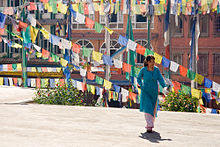|
|
||
|
Prayer
flag is
a colorful rectangular,
often found strung along mountain ridges and peaks high in the.
They are used to bless the surrounding countryside and to carry the prayers they contain to the heavens.
|
||
|
Legend ascribes the origin of the prayer flag to Gautama
Buddha, whose prayers were written on battle flags by the
Nepalese monks
as a way of signifying their commitment to harmlessness. This
know-ledge was carried into Tibet by
800 AD, and the actual flags were introduced no later than 1040 AD,
where they were further modified. Even during the Chinese Cultural Revolution, prayer flags were not entirely eliminated though many traditional designs may have been lost. |
 Prayer flags in Kathmandu, Nepal. |
|
|
There are two
kinds of prayer flags: horizontal ones and vertical ones.
Horizontal flags are square or rectangular and are connected along
their top edges to a long string. They are commonly hung from high
to low between two objects (e.g., a rock and the top of a pole) in
high places such as the tops of temples, monasteries and mountain
passes. These are the prayeflags most commonly known in the West.
Vertical prayer flags are like national flags, on a pole and are
commonly flying from peaks and rooftops. |
||